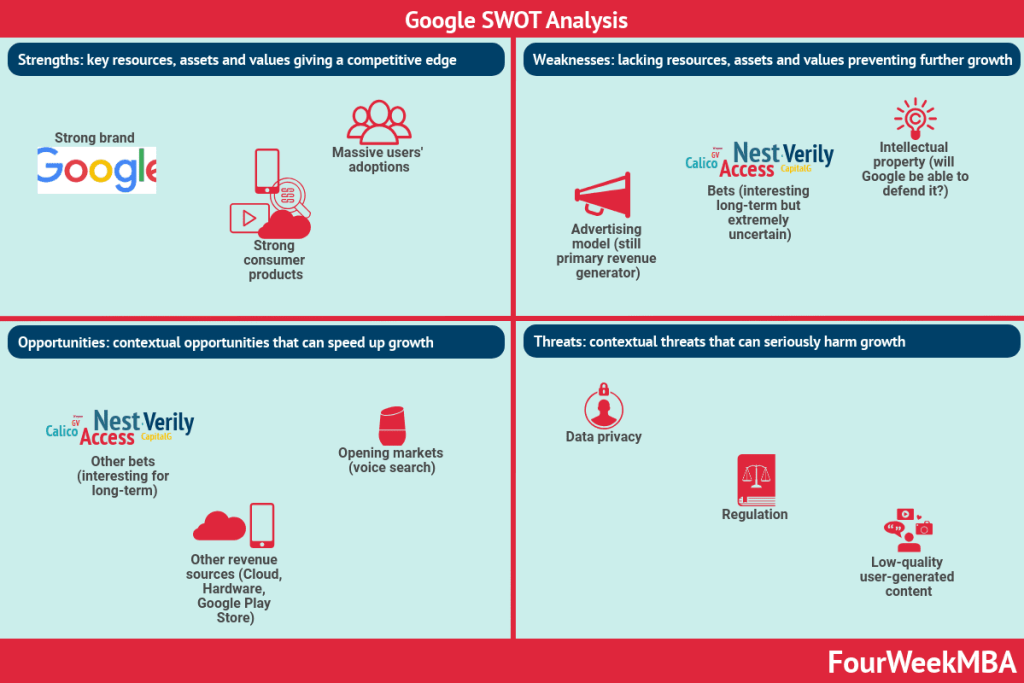Apple can leverage a strong consumer brand and set of successful products as a strength. Yet the company is still too reliant on the iPhone as a primary revenue stream. Though Apple is working to open up new markets as an opportunity, it has to make sure to sustain its stores’ sales.
Strengths


- Brand: Apple is among the most valuable recognized consumer brands in the world. With the ability to launch new, breakthrough successful products in the last two decades, Apple devices have become for millions of people part of their daily lives. This alone can make Apple still a viable company in the next decade.
- Products: Apple products are still among the most innovative companies. It opened up new markets when it launched the iPod, the iPad, and the iPhone. And now it’s redefining the boundaries of new markets with other devices like wearables (Apple Watch) and other accessories (AirPods and glasses). If any of those products will turn out to be successful Apple can once again create a whole new category.


Weaknesses
- iPhone saturation: the iPhone has been an incredible success for Apple, however, it also is the primary revenue stream. And if the primary revenue stream slows down that affects the whole company. That is what’s happening as sales of the iPhone have reached saturation.
- Lack of revenue diversification: the iPhone represented more than 50% of Apple revenues as of 2019, and while Apple sells other devices (Mac, iPad, iPod, and accessories), the company’s bottom line is still too skewed toward the iPhone. However, Apple has been able to diversify its revenues in the last few years.

Opportunities

- New strong accessory market: Apple’s revenues in accessories have been among the fastest-growing. This creates massive short-term opportunities for Apple, as the company keeps monetizing the customer base developed on top of the iPhone.
- Other revenue streams with high potential growth: Beyond accessories, wearables might become also a segment with extremely high growth potential.
- Opening adjacent markets with high potential: A whole new set of products, like Apple Glasses or accessories able to monitor the biometrical data of users, might become a whole new category for the company, thus opening great opportunities.
Threats

- Competition, markets for the Company’s products and services are highly competitive and Apple is in the midst of aggressive competition in all areas of its business.
- The supply of Components can also represent a risk. True, most of Apple’s product components are generally available from multiple sources, however, certain components are available from a single-source. This might make the production of new devices slower, less reliable and in any case, increase the cost of production.
- Intellectual Property: If the company fails to protect its intellectual properties that can also become a future threat.
- Performance of carriers, wholesalers, retailers, and other resellers: a major chunk of Apple’s distribution goes through indirect channels like carriers and resellers. Changed agreements or inability to fuel this channel might result in massive losses in terms of product distribution and sales.
- Performance of direct stores: Apple has built over the years also a direct distribution system, where customers could purchase directly from those stores. While those stores have been the temples of Apple’s success. If the company will fail in attracting a continuous flow of customers in those same stores, they might become an unbearable cost, thus making the transition from temples to cathedrals in the desert.
Key Highlights:
Strengths:
- Strong brand recognition and successful product lineup.
- iPhone and Services are primary revenue drivers.
- Innovation in product categories and brand philosophy.
- Diversification of revenue streams, particularly through accessories and wearables.
Weaknesses:
- Reliance on iPhone as a major revenue source.
- Lack of revenue diversification in the past.
- iPhone saturation impacting overall growth.
Opportunities:
- Growing accessory market and monetizing existing customer base.
- High growth potential in wearables segment.
- Opportunities in opening adjacent markets with innovative products.
Threats:
- Intense competition in all areas of Apple’s business.
- Reliance on indirect channels for sales amplification.
- Supply chain risks due to certain components being single-sourced.
- Intellectual property vulnerability and potential loss of protection.
- Performance challenges with carriers, resellers, and direct stores.
Read more: What Is A SWOT Analysis, Amazon SWOT Analysis
Read next:
- Apple Business Model
- The Power of Google Business Model in a Nutshell
- How Does Google Make Money? It’s Not Just Advertising!
- How Does DuckDuckGo Make Money? DuckDuckGo Business Model Explained
- How Amazon Makes Money: Amazon Business Model in a Nutshell
- How Does Netflix Make Money? Netflix Business Model Explained
- How Does Spotify Make Money? Spotify Business Model In A Nutshell
- The Trillion Dollar Company: Apple Business Model In A Nutshell
- DuckDuckGo: The [Former] Solopreneur That Is Beating Google at Its Game
- How Does Facebook Make Money? Facebook Hidden Revenue Business Model Explained
Other resources for your business:
- Successful Types of Business Models You Need to Know
- Digital Business Models Map
- Business Strategy: Definition, Examples, And Case Studies
Related to Apple

















Read next:
- Apple Business Model
- Apple Distribution Strategy
- The Apple-NeXT Deal
- A Decade-Long Evolution Of Apple Sales By Products
- Who Owns Apple?
- Apple vs. Google Business Models
SWOT Analysis Case Studies


















Read Next: SWOT Analysis, Personal SWOT Analysis.









